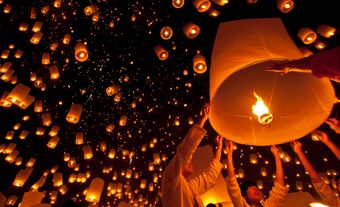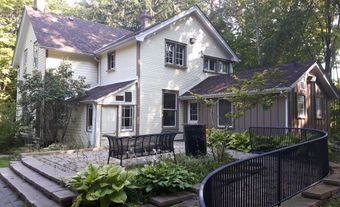Markham, Ontario, incorporated as a city in 1971, population 338,503 (2021 census), 328,966 (2016 census). Markham is located immediately northeast of Toronto. It is one of nine municipalities that make up the Regional Municipality of York. The Rouge River cuts through the municipality diagonally, connecting to Rouge National Urban Park. Initially an agricultural community, Markham is now known for its technology businesses and ethnocultural diversity.
Throughout history, the Markham area has been home to different Indigenous groups, namely the Huron Wendat, Haudenosaunee and Anishinaabeg. The land is covered by Treaty 13 and the Williams Treaties.
Indigenous Peoples and Treaties
Indigenous peoples have lived in the Markham area since the end of the last Ice Age, around 10,000 years ago. When French explorers arrived in the area in the early 1600s, they encountered the Huron-Wendat. This First Nation’s territory stretched roughly from the shores of Georgian Bay to the northern shore of Lake Ontario. Between 1634 and 1642, a series of epidemics reduced their numbers. In 1648 and 1649, the Haudenosaunee defeated and dispersed the remaining Huron-Wendat. Many joined the Haudenosaunee.
In the years that followed, the Haudenosaunee established settlements north of Lake Ontario. By the late 1600s, however, they began to abandon these settlements. At the same time, the Anishinaabeg, including the Mississauga, began migrating from the area around Lake Superior into the territory the Haudenosaunee left behind.
In 1805, Mississauga chiefs met with colonial administrators and signed Treaty 13, also known as the Toronto Purchase. The treaty transferred approximately 250,800 acres (1,015 km2) from the Mississauga to the colonial government. In return, the Mississauga received 10 shillings and fishing rights along the Etobicoke Creek. While the majority of this treaty is centred on modern-day Toronto, Vaughan and King Township, the southwest corner of Markham is also included. The remainder of Markham is covered by the Williams Treaties, signed in 1923. Today, Indigenous peoples make up 0.3 per cent of Markham’s population.
Settlement and Development
Despite the Mississauga not signing treaties until 1805 and 1923, in 1792 colonial administrators “opened” the Markham area for settlement. Many early settlers were from Britain. The township was named for William Markham, the Archbishop of York, England, and a friend of John Graves Simcoe, Lieutenant Governor of Upper Canada.
A British firm looking to colonize land in New York state hired a German-born merchant, William Berczy, in 1791. Berczy found over 200 people willing to immigrate, mostly north Germans. Arriving in 1792, the company denied Berczy’s group the land and supplies they were promised. At the time, Simcoe hoped to develop the area around Upper Canada’s capital, York (Toronto). He offered Berczy and his contingent Markham Township, an area nearly the size of the modern city. However, Simcoe’s schedule for development of the area proved too ambitious. He wanted them to clear trees up to Lake Simcoe within a year and to create Yonge Street. (Yonge Street is now part of Markham’s western border.) With little time to farm or build mills, the settlers faced starvation. Many left the area. Despite these challenges, Berczy’s settlers founded multiple communities now within the city of Markham, including Unionville.
In 1794, settlers arrived at present-day Thornhill. They established a village early in the next century. The community was partly in Vaughan Township and partly in Markham Township. While it was a “police village” from 1931 to 1971, modern Thornhill is again split between Vaughan and Markham.

At the end of the American Revolution, many Mennonite families in Pennsylvania worried about having to serve in the military. Mennonites belong to a part of Christianity called Anabaptism. Most Anabaptists are pacifists, meaning they disagree with the use of violence or military service. Upper Canada law exempted Anabaptists from military service. In 1804, Peter Reesor led a group of these “Pennsylvania Germans” to the township. In 1825, they founded the village of Reesorville, later renamed Markham.
Much of the land was used for agriculture, or complementary activities like milling. The Markham Fair was founded in 1844. It is now one of Canada’s oldest and largest agricultural events.
The Town of Markham was created in 1971. While most of Markham Township was included in the new municipality, sections were annexed by Richmond Hill to the west and Whitchurch-Stouffville to the north.
Population

Markham is Ontario’s seventh most populous city and the largest in York Region. Markham calls itself “Canada’s most diverse city.” According to the 2016 census, the two most prominent ethnic groups are Chinese people (45.1 per cent) and South Asian people (17.8 per cent). The majority of immigrants living in Markham cite their country of birth as China, followed by Hong Kong, India, Sri Lanka and the Philippines.
Of the city’s 121,315 residents whose mother tongue was a Chinese language, 78 per cent say that it is the language they speak most at home. This is reflected in various ways, such as specialized malls, and the local media.
Economy and Labour Force
Markham is known for its large technology sector. Over 900 technology firms are based in the city, including the Canadian head offices of IBM, Huawei Technologies, Honda, Lenovo, Toshiba, and GE Energy. Life sciences is also a growing industry. Buttonville Airport, located in the city’s west end, is one of Ontario’s busiest airfields.
Government and Politics

Markham is divided into eight wards, each of which elects one councillor to city council. Council also includes the Mayor and four regional councillors, who also serve at York Regional council.
The Regional Municipality of York includes nine municipalities: Aurora, East Gwillimbury, Georgina, King, Markham, Newmarket, Richmond Hill, Vaughan, and Whitchurch-Stouffville. Markham has 5 of the 21 votes on council.
Markham’s city government handles services like recreation, libraries, fire services, and waste and recycling. York Region handles health, transit and social services.
Cultural Life
Rouge National Urban Park, partly in the city, is the largest urban park in North America. The Varley Art Gallery is named for the Group of Seven artist Frederick Varley. Varley lived in Unionville in his final years.
Actors from the city include Hayden Christensen (Star Wars prequels), Paula Brancati (Degrassi: The Next Generation), Mena Massoud (Aladdin), and Iman Velani (Ms. Marvel). Other residents include CTV news anchor Lloyd Robertson, and YouTuber Lilly Singh.
The Markham Pan Am Centre was built to host the badminton, table tennis, and water polo events at the 2015 Pan Am and Parapan Am Games.
Olympic sprinter Andre De Grasse was raised in Markham. He is the first Canadian to break both the 10-second barrier in the 100m dash and the 20-second barrier in the 200 m dash.

 Share on Facebook
Share on Facebook Share on X
Share on X Share by Email
Share by Email Share on Google Classroom
Share on Google Classroom



